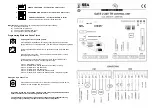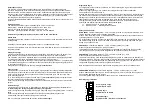
General Description:
The GATE 2 - 24V has been specifically designed to control all SEA low voltage swing gate
operators. Programming of the motor run and delay timings is carried out by push button (P2 & P3).
Features include: A normal paired motor start input - Pedestrian start input that controls one gate
(motor 2) of pair - Photocell and Electric Lock control - Selectable 12 or 24v accessory voltage output
– ‘led’ status indication – Adjustable motor run speed controller (RV1) - Dip switch selectable
operating logics – Battery back-up control (optional).
An in-built non-adjustable AMPSTOP device automatically switches off the supply to the motor(s) at a
preset level.
Operating Logics
The Gate 2 24v has three types of operating logics. They are as follows:-
Step by Step – Selected by setting ‘dip switches’ 1 OFF and 2 OFF.
Security – Selected by setting ‘dip switches’ 1 OFF and 2 ON.
Automatic – Selected by setting ‘dip switch’ 1 ON - dip 2 is then disabled
Automatic Logic takes priority, when switch 1 is ON switch 2 is disabled.
Please Note:
All Changes of the ‘logic’ settings or timings must only be carried out when the gate(s) is at rest in the
closed position.
Operating cycles are initiated by giving either a ‘start’ or a ‘pedestrian start’ input.
On ‘power-up’ of the Gate 2 24v, the first start input given will initiate an opening cycle regardless of
the gate(s) position.
Step by Step Logic
This is a sequential logic. From the gate(s) closed position a ‘start’ input’ will open the gate(s). The
gates will remain in the open position until the next ‘start’ input is given to close the gate(s).
The ‘slowdown’ stage occurs toward the end of an operating cycle and the motor(s) stopping position
is controlled by either the in-built AMPSTOP device or expiry of the run time??
A ‘start input’ given during an opening or closing cycle stops the gate(s) movement – The gate(s) stay
in this position awaiting the next ‘start’ input. When this second (next) input is given the gate(s) travel
on the opposite direction i.e.
If the gate(s) were stopped during opening –
They will start to close.
Security Logic
This logic works in a similar way to ‘Step by Step’ logic apart from the following important differences:-
When the gate(s) reach the open position they will pause for the preset time and automatically close.
A ‘start’ input given during the open pause time cancels the automatic cycle. The next ‘start’ input
given closes the gate(s).
i.e. A ‘start’ inputs given during the open and close cycle
will still halt
the gate(s) movement and the
next ‘start’ input given inverts the gate(s) original direction.
A ‘start’ input given during the open pause cancels the pause time, the next ‘start’ input will close the
gate(s).
Automatic Logic
This logic works in a similar way to ‘Automatic Logic’ apart from the following important differences:-
A ‘start’ input given during the gate(s) opening cycle is ignored.
A ‘start’ input given during the gate(s) closing cycle, stops and re-opens the gate(s) after a 1.5 second
delay.
A ‘start’ input given during the open pause time recharges and lengthens the pause time.
A maintained ‘start’ input will delay closing until it is removed.
N.B. For ‘hold open’ switches and time clocks, use
Automatic Logic
.
Single Gate Logic:
For single gate (motor) control (dip switch 3 ON) – When selecting this logic, previously described
logics remain unaltered.
When using ‘single gate logic’, dip- switch 4 - Reversing Stroke Logic need consideration.
The explanation of ‘reversing stroke’ is:
Starting with the gate(s) at rest in the closed position - When a ‘start’ input is given, the first action of
the motor(s) is to run towards the closed direction for approximately 1 second before reversing and
starting to run toward the open direction. The electric lock is energised before the motor starts to run
towards open and stays energised for approximately .4 of a second after is starts opening.
This logic is normally used to overcome ‘wind induced face pressure’ problems that are often
associated with electric locks that are fitted to solid sheeted gates.
1)
Dip-switch 4 OFF – No Reversing Stroke
2)
Dip-switch 4 ON – Reversing Stroke selected.
Safety Control Inputs:
STOP INPUT
: Terminal 5 & Negative -. This is a ‘normally closed (nc)’ input and will require a wire-
link to a negative– terminal if a ‘Stop Button’ is
not
fitted.
When a ‘Stop’ command is given, it immediately stops operator movement or cancels the automatic
cycle if the gates were on open pause.
On reconnection of the Stop Link, the first ‘Start’ input given will either run the gates toward open if
the motors running at the time of the command or close the gates if the ‘Stop’ command was given
during a ‘open pause’ period.
PHOTOCELL
: Terminal 6 & Negative -. This is a ‘normally closed (n.c.)’ input.
When the photocells infra-red beam is broken it either:-
Immediately halts and re-opens a closing gate(s) or if the beam is broken during the ‘open pause
time’, the pause time is re-charged and lengthens the time before the gate(s) start closing.
PHOTOSTOP
: Terminal 8 & Negative -. This is a ‘normally closed (n.c.)’ input.
When the photocells infra-red beam is broken:-
If the motors are running, it immediately stops
all
gate movement, no matter which the direction the
gate(s) are travelling. When the infra-red beam is restored (obstruction cleared), the gates will always
run towards open. If the photocell beam is broken during the ‘open pause time’, the pause time is re-
charged and lengthens the time before the gate(s) start closing.
Both the above Photocell Inputs are inactive when the gate(s) are at rest in the closed position.
PEDESTRIAN START
input: Terminal 2 & negative -. This is a ‘normally open (n.o.)’ input.
When a Pedestrian Start input is given, the first opening motor (motor 2) will open the one gate of a
pair and allow pedestrian access./egress.
The normal paired ‘Start’ input (terminal 3) has priority over a ‘Pedestrian Start’ input.
Operating Logic Selection
1
2
1
2
1
2
ON
Step – by Step Logic
Dip Switch 1 & 2 OFF
Security Logic
Dip Switch 1 OFF & 2 ON
Automatic Logic
Dip Switch 1 ON – Switch 2 is now inactive


